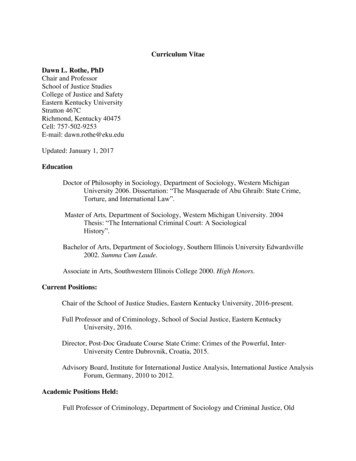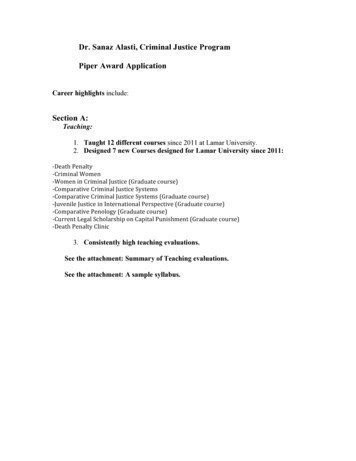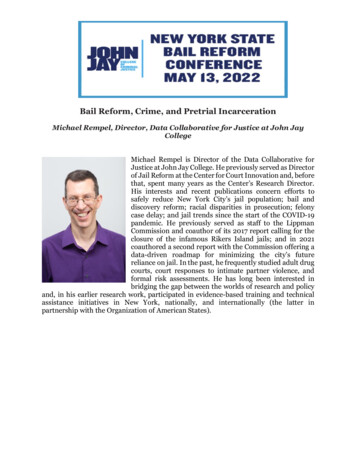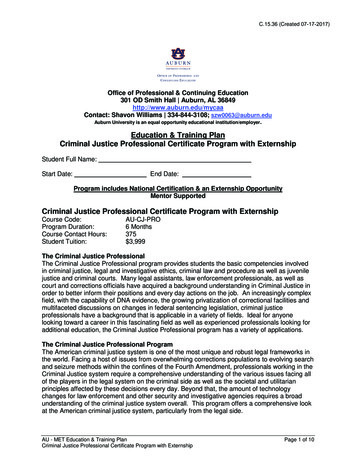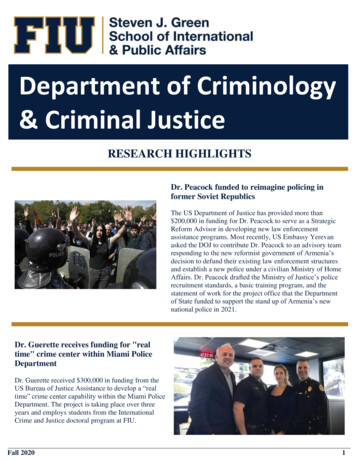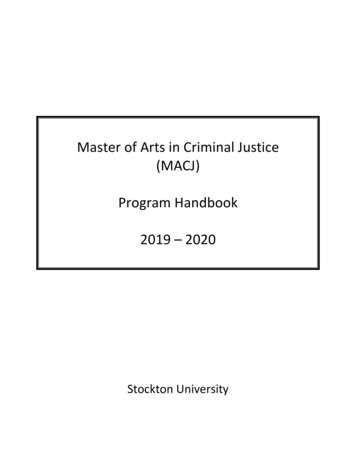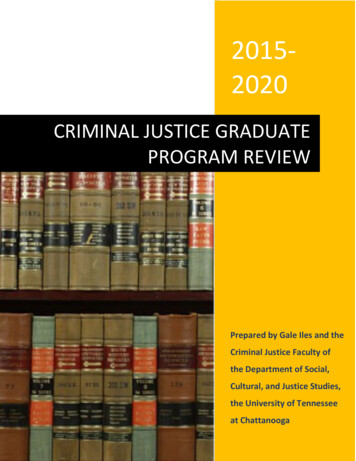
Transcription
20152020CRIMINAL JUSTICE GRADUATEPROGRAM REVIEWPrepared by Gale Iles and theCriminal Justice Faculty ofthe Department of Social,Cultural, and Justice Studies,the University of Tennesseeat Chattanooga
TABLE OF CONTENTSList of Figures3List of Tables3Preface/History4Part 1: Learning Objectives (Outcomes)5Part 2: Curriculum11Part 3: Student Experience16Part 4: Faculty20Part 5: Learning Resources28Part 6: Support361
LIST OF FIGURES3.1Student Enrollment: Gender, Ethnicity163.2Enrollment Trends184.1Student Credit Hours214.2Gender224.3Race/Ethnicity22LIST OF TABLES1.1Abbreviated Student Evaluation for Fall 2018102.1.Past Three Years of Course Offerings132.2Summary of Program Learning Outcome154.1Educational Background of Faculty Members236.1Class Enrollments for the Last Three Years332
PREFACE/HISTORYDepartmental StructureCriminal Justice is part of the Department of Social, Cultural, and Justice Studies, in the Collegeof Arts and Sciences at the University of Tennessee at Chattanooga. The program offers aMasters of Science Degree, which prepares students for leadership and management positionsacross the field. Courses are available in the evening and online, and provide students withopportunities to study a wide range of subjects from police, courts and corrections to victimologyto terrorism.i.1 Organizational ChartRandy BoydInterim President of the University of Tennessee SystemSteve AngleChancellor of the University of Tennessee at ChattanoogaJerald L. HaleProvost and Senior Vice Chancellor for Academic AffairsJoe WilferthInterim Dean of the College of Arts and SciencesLynn PurkeyInterim Head of the Department of Social, Cultural, and Justice StudiesKaren McGuffeeAssociate Head of the Department of Social, Cultural, and Justice StudiesGale IlesGraduate Program CoordinatorMissionThe mission of the Department of Social, Cultural, and Justice Studies is to prepare students forprofessional and personal success in the context of a strong liberal arts education. TheDepartment is committed to coursework that is grounded in theory, research, and communityengagement to help students prepare for careers in their respective fields. Emphasis is placed onintellectual, experiential, critical thinking, and problem-solving abilities that will preparestudents to become ethically informed, culturally sensitive, engaged scholars, able to addressglobal, national, regional, and local challenges.More specifically the mission of the Criminal Justice Program is to help students acquire a solidfooting in the core of the criminal justice system and to explore crime and its social, cultural, andpolitical implications.Departmental HistoryDuring the 1990s the Criminal Justice Program was part of the School of Social and CommunityServices, which in 2003 split into different departments, including Criminal Justice. As ofAugust 1, 2015, the Department of Criminal Justice merged with the Department of Sociology,Anthropology, and Geography to form the Department of Social, Cultural, and Justice Studies.TrendsGraduate enrollments have dropped nationally and at UTC. However, enrollments in theCriminal Justice graduate program have remained steady over the past five years, although theyhave dropped by 4% from last year.Response to Previous Findings and RecommendationsOverall the last review was favorable. The undergraduate review in general discusses previousfindings and recommendations for the program in general. However, a few areas relate3
specifically to the graduate program. In particular, the reviewer indicated the need for morefaculty for the graduate program, suggested gradually moving towards creating an onlinedistance program, and encouraging graduate students to take relevant courses outside of theprogram.The reviewer indicated that the graduate program could not continue to grow at the same ratewithout new resources, particularly without more faculty members. He also indicated that itwould be extremely difficult to sustain the same level of engagement, mentorship, andscholarship, without lowering the teaching load. The department is currently searching for threefaculty members, two assistant professors and a lecturer, which are filling lines that have beenvacant, which is an improvement over the past few years, although the program needs morefaculty.In regards to the suggestion of gradually creating a distance learning program, the departmenthas steadily increased the number of online classes in the graduate program, but it is not fullyonline. This is a choice on the part of faculty members, who feel that offering a completelyonline graduate program might diminish the program’s reputation and might not be suitablepedagogically. Many top students in the program have gone on to prestigious programs. Facultyfear that national reputation of the program will diminish, if it is fully online, and they also fearthat students will only take online classes, if given the opportunity, which would lead to thedemise of the face-to-face program. Moreover, certain courses particularly those that are moretheoretical or difficult lend themselves better to a face-to-face environment, and it would becounterproductive to offer them online.PART I. LEARNING OUTCOMES1.1 Program and student learning outcomes are clearly identified and measurableThe learning outcomes of the program are clearly specified in the catalog (see this link:http://catalog.utc.edu/preview program.php?catoid 30&poid 5442&returnto 1048.The goals and objectives are as follows: Analyze the major historical and contemporary issues facing the criminal justice system in orderto evaluate the nature, extent, causation, and prevention of crime. Apply and critique the major theories relevant to crime and identify how they affect policydecisions. Explain the inter-dependent operations of the major components of the criminal justice system(i.e., police, courts, correctional agencies) and the political, legal, ethical, and socioeconomicenvironments in which they operate, as well as the implications of these relationships for victims,offenders, justice professionals, and society. Illustrate how gender, race, ethnicity, age, social class, and sexual orientation function at both themacro and micro level in the criminal justice system. Apply the skills and methods in criminal justice research, including how to acquire, analyze,interpret, and disseminate both quantitative and qualitative data. Students will be able to communicate effectively, both orally and in writing, and demonstratebasic knowledge of information technology as applied to criminal justice research and practice4
Condensed into three broad categories, the fundamental educational outcome of our graduate program isto ensure that graduates from the program will emerge with (1) mastery of core material, (2) researchrelated skills and (3) the professional communication skills and abilities needed for employment.1.2 The program uses appropriate evidence to evaluate achievement of program and student learningoutcomes.As noted above the six learning outcomes of the program can be summarized into three broad categories:(1) mastery of core material, which includes the integration of program skills, (2) research-related skillsincluding analytic, critical, evaluative and empirical skills, and (3) the professional communication skillsand abilities needed for employment.Mastery of Core Material OutcomeGraduates will demonstrate their ability to master core material in the field including familiarity with thestructure, operation of the justice systems, criminological theory and research methods. This is assessedby the percentage of comprehensive exams passed and successful completion of a thesis.To be eligible to take the exam, the student must be within one semester of program completion,successfully completed or be concurrently enrolled in all core classes and have a cumulative grade pointaverage of 3.0 (CRMJ 5000, 5010, 5020 and 5030). The comprehensive exam is a two-part process. Sixweeks prior to the official exam date, students will electronically receive Part 1 of the exam. This partrequires students to respond to a policy question in the form of a research proposal that includes anintroduction, literature review, theoretical framework, methodology, and limitations of the study. Theliterature review is expected to contain a discussion that outlines theoretical issues associated with thetopic and outline the strengths and weaknesses of their study. The policy question mimics real-life issuesfacing society and is designed to assess students’ ability to analyze the major historical and contemporaryissues facing the criminal justice system in order to evaluate the nature extent, causation, and preventionof crime. For example, students taking the comprehensive exam in Spring of 2019 were asked to constructa research proposal that addresses the “#MeToo Movement.” Previous exams have addressed similar hotbutton topics such as cyberbullying, the war on drugs, the death penalty, and the treatment of juveniles inthe criminal justice system (see appendix 1.1 for sample copies of past exams). The theoretical portion ofthe exam is meant to assess students’ ability to apply and critique the major theories relevant to crime andidentify how they affect policy decisions.On the official date of the comprehensive exam the student receives Part II of the exam. They have 6hours to respond to research findings and tables pertinent to the research question. This part of the examrequires students to demonstrate their ability to apply the skills and method in criminal justice research,including the interpretation of data, discussion of the significance of the finding and discussion of thepolicy implications of the results. Within the interpretation of the data, students are assessed on theirability to illustrate how factors such as gender, race, ethnicity, age, social class, and sexual orientationfunction at both the macro and micro-level in the criminal justice system. They are also required topresent recommendations based on their literature review and the findings of the data. The comprehensiveexam is graded by two reviewers assigned by the graduate coordinator. Blind reviewers are given agrading rubric and scoring sheet (see appendix 1.2). Based on performance, reviewers can make 1 of 3recommendations; pass, marginal pass, or failure. A student passes the comprehensive exam if bothreviewers issues a pass. If there is a split decision, a third reviewer will grade the exam. After this splitposition, if the student still receives a “marginal pass,” the student is automatically required to take anoral exam. The purpose of the oral examination is to give reviewers the opportunity to follow up on issuesin the paper and/or to flush out details in cases where the student appears to be on the margins of passing.An oral exam may also be requested if there are doubts that the student completed the work on their own.5
Within the last five years 29 students have taken the comprehensive exam. Of the 29 students, 24 (82.7%)successfully passed the exam. Among the five who failed the exam, two (6.7%) failed the exam on theirfirst attempt and have not yet scheduled their second attempt. The remaining 3 students (10.3%) failed theexam on their second attempt and two have subsequently left or were dismissed from the program.According to graduate school and program policy, after a failure on the second attempt a student issubject to program dismissal. However, a student can petition their dismissal and if granted can receive athird attempt at the exam. During the summer of 2019, one such student failed her second attempt of theexam. Her petition for readmission this fall was granted but she has not yet scheduled her third attempt atthe exam.Students not taking the comprehensive exam are required to complete a thesis research project under thesupervision of one faculty chair and two other graduate faculty members, which together form a thesisadvisory committee. Similar to comprehensive exams, theses also provide evidence related to programassessment, demonstrating students’ ability to master core content as well as their ability to integratematerial and apply skills learned in the program. It is meant to represent the culmination of an originalresearch project that is focused on a criminal justice issue chosen by the student but within an area ofexpertise held by one or more members of the thesis committee. Theses are prepared according to therules of the graduate school. Students completing a thesis are required to register for CRMJ 5999 (Thesis)and must maintain enrollment in thesis until the project is completed; the student must be enrolled for atleast two hours of thesis during the semester the thesis is submitted.Similar to the comprehensive exam, the thesis project requires students to write a literature review,provide a theoretical frame work, propose a methodology and provide limitations of the study. However,unlike the comprehensive exam option, the students’ completion of a thesis is expected to address theirown research question or hypothesis via the collection of primary data and/or the analysis of secondarydata. Students who have made no progress towards thesis completion receives a grade of NP. SP(Satisfactory progress) grades are recorded for those semesters when adequate progress occurs. A finalgrade for the thesis is recorded when the thesis is deposited in the library. At that time, the six most recentsemester hours of previously SP graded thesis credit is recorded as “A” or “B”.Criminal Justice thesis from 2014 to present can be access through this link: https://scholar.utc.edu/.Between 2015 and 2019, 10 students completed a thesis. Among those students, 3 have gone on topublish a peer-reviewed article centered on their thesis (Oladipupo Adegun, Caleb Trenthan and AprilBennett). The thesis of two other students (Tessa Cole and Katelyn Hancock) are currently being revisedand resubmitted for publication.Research-Related OutcomeThe Criminal Justice Program promotes both a theoretical and applied understanding of the criminaljustice system. Provision of intellectual, experiential, and problem-solving activities are given highpriority. Whether students chose the comprehensive exam option or the thesis option, all students areassessed on their ability to interpret data and comprehend applied theory-driven empirical research.Students in Research Methods I are given experience in locating and reading scholarly articles and areexpected to demonstrate an understanding of empirical research. Additionally, students are assigned amajor writing activity that requires the inclusion of “an introduction, literature review, proposedmethodology, and limitations of the proposed study.” This is reinforced again in Research Methods II,where students are once again given experience in finding, reading and comprehending scholarly articles.For example, in Spring of 2019, the final exam for CRMJ 5020 was as follows:6
Final Exam TopicIn 2016, the major focus for the presidential election is crime and criminal justice policies (e.g., generalcriminal justice policies, drugs, death penalty, sentencing issues, correctional issues, etc.). ThePresidential candidate has tasked her head researcher (you) to determine attitudes of the generalpopulation and how different segments of the population perceive crime throughout the country. Onceyou have collected this data, you will report the information to the candidate, so she can establish anelectable platform.Your study must contain the following elements:1. Introduction & Literature Reviewa. Review of general attitudes toward crime and criminal justice policiesb. Attitudes of differing segments of the population (gender, race/ethnicity, socioeconomicstatus, etc.)2. Methoda. Hypothesisb. Sample and sampling proceduresc. Research design, measurements, or instrumentsd. Identification of the independent and dependent variables; operationalization of thesevariables.3. Limitations of the studyThe assignment is designed to mimic Part I of the comprehensive exam and the first four chapters of thethesis. To demonstrate students’ ability to integrate research, criminological theory and policy issues (alearning outcome of CRMJ 5000 Pro-Seminar), students enrolled in Criminology (CRMJ 5030) in theSpring of 2019 were given a writing assignment that required them to apply the positivist explanation ofcrime to the landmark U.S. Supreme Court case of Buck vs. Bell. The assignment is designed to providestudents with experience in theory application, an important component of the comprehensive exam andthe theoretical framework of a thesis.Assignment for Criminology – CRMJ 5030 (Spring 2019)I.II.III.IV.Statement of the IssueA. Briefly research and discuss the background of the Buck v. Bell, 274 U.S. 200 (1927)case.B. What was the court’s decision and rationale?Theoretical FrameworkA. What is the argument/premise of the early positivist explanation of crime?i. This is where you will demonstrate your understanding of the key ideas presentedin the assigned readings and class discussion).ii. NOTE: This is a theory class so your discussion on this section of the papershould be fully detailed and complete. You are free to use outside resources tohelp with your understanding of the theory. Be sure to include them in yourreference page.Theory ApplicationA. How does the case and ruling relate to the thinking of the early positivist explanation ofcrime?i. This is where you will demonstrate your ability to apply an event to what youhave learned about the positivist explanation of crime/deviant behavior.Policy ImplicationA. What effect did the courts’ ruling have on laws in the U.S.?7
B. Do you think the court made the right decision? Why or why not?i. Your response should include a discussion of the strength and/or weaknesses ofthe positivist school of thought.C. Should our deeds be judged by society (people) or science (genetics)?D. Better yet, should someone’s life be read and judged not after they have committed a badact but before they are even born?Additional opportunities for experience in conducting research and theory application are provided inelective courses. Students in Organizational Crime (CRMJ 5270), for instance, are assigned the task ofapplying a theory to a form of white-collar crime. In Drugs and Crime (CRMJ 5370) students are asked toapply Becker’s labeling theory to an analysis of the film “Reefer Madness.” See samples of syllabi inappendix 1.3.Professional Communication Skills OutcomeGraduates of the program are expected to demonstrate their ability to communicate effectively, bothorally and in writing, and demonstrate basic knowledge of information technology as applied to criminaljustice research and practice. Opportunities for developing professional communication skills areavailable in our internship course (CRMJ 5600). While we do not have a requirement that studentcomplete an internship, we do strongly advise students to consider taking internships as a way to attainexperience in the field, especially for those without prior work experience in criminal justice. Theinternship requires a personal interview with the internship coordinator. The internship coordinator is alsoresponsible for their supervision and works as a liaison between the student and the placement supervisor.The internship is evaluated by both faculty and placement supervisors. Faculty grade written assignmentsand placement supervisors rate student performance on diverse indicators. Within the last two years, 15students have enrolled in internships.Internship placements includes: Tennessee Bureau of Investigation (TBI)Bureau of Alcohol, Tobacco and Firearms (ATF)Federal Bureau of Investigation (FBI)U.S. MarshallsProbation and ParoleHamilton County Sheriff’s OfficeJuvenile CourtChattanooga Police DepartmentThe Next Door (A women’s correctional pre-release center)District Attorney Office (Cold Case Unit)One hundred percent of the internships have resulted in successful completion and some have even led topotential job opportunities (e.g., Calvin Bibbs interned at Probation and Parole and has been offered aposition based on his internship performance). Caleb Smith interned at ATF and according to hissupervisor:Mr. Smith has been a great asset, assisting with numerous projects. He is often assigned complex tasks and alwayssuccessfully completed them with little supervision. Also, his ability to work collaboratively is outstanding.Alexandria Martin interned with the U.S. Marshall and her supervisor commented that:8
Alex is very professional and handles herself well. She is very well spoken, intelligent, and respectful. Alex will bean excellent addition to any agency she decides to be a part of. Alex was very well prepared for this internship.In addition to internships, comprehensive exams and theses also provide opportunities to demonstrate andassess communication skills. The comprehensive exam provides the opportunity for students todemonstrate their ability to communicate in writing. Students completing a thesis demonstrate not onlytheir ability to communicate in writing but also their ability to communicate orally. Additionally, studentsare required to give some form of oral class presentation in a number of courses such as Pro-Seminar(CRMJ 5000-Fall 2018) and Research Methods I (CRMJ 5000). Opportunity to demonstrate oral skillswere also available in elective courses such as Organizational Crime (CRMJ 5270) where students arerequired to select a week to lead the class discussion. Mandatory discussion boards are also used to assessstudents’ professional communication skills for online classes.Altogether, the variety of evidence used to evaluate mastery of core material, research-related skills andprofessional communication skills and abilities suggest achievement of program and student learningoutcomes.1.3 The program makes use of information from its evaluation of program and student learningoutcomes and uses the results for continuous improvementThe graduate coordinator with the assistance of the curriculum committee regularly reviews thepercentage of students that pass comprehensive exams and complete theses. Based on results of thereview, changes are made to improve success rate. For instance, over the last year, greater efforts weremade to better prepare students for passage of the comprehensive exams. To that end, Policastro beganusing an old comprehensive exam as a final exam for Research Methods II. The change not only gavestudents hands on experience on taking the comprehensive exam but since the sections of the exam (e.g.,Introduction, literature review, methods and limitations of the study) are similar to that of theses, it alsoprovided hands on experience for those completing a thesis. While it is too early to see the full effects ofthe change (Students in her class have not yet taken the comprehensive exam) there appears to be somemodest success as students appear less unaware of the format of the comprehensive exam andconsequently more prepared for the exam. To that end, Crittenden is currently working on incorporating asample of the comprehensive exam into her Research Methods I course.As shown below, results from Fall 2018 student evaluation reveals that 95% of students strongly agree,agree, and somewhat agree that the course content addressed the learning outcomes of the course(compared to 95% for College of Arts and Sciences (CAS) and 95% for the University as a whole). Aslightly lower percentage (90%) said the course structure assisted them in achieving the learningoutcomes of the course (90% for CAS and 90% for the University). Equally important is the 91% ofstudents who strongly agree, agree, and somewhat agree that they achieved the learning outcome of thecourse (89%-CAS, 90%-University) and the 89% who said the courses encourage their use of criticalthinking (90%-CAS, 92%-University). See appendix 1.5 for the complete student evaluation for Fall2018.9
Table 1.1: Abbreviated Student Evaluation for Fall 2018Strongly Agree(%)Somewhat Agree(%)Neither Agreenor Disagree(%)SomewhatDisagree (%)Disagree (%)Strongly The coursecontentaddresses thelearningoutcomes of thiscourse.The coursestructure assistsme in achievingthe learningoutcomes of thiscourse.I am achievingthe learningoutcomes of thiscourse.The courseencourages myuse of criticalthinking skills.Agree 104232422222211.4 The program directly aligns with the institution’s missionThe University’s mission statement emphasizes the achievement of excellence via active engagement ofstudents, faculty and staff, the embracement of diversity and inclusion, inspiring positive change and theenriching and sustaining of community. The mission of the Master of Science degree in Criminal Justiceis to achieve excellence by preparing graduates for leadership, education, and research roles in the field ofcriminal justice. Align with the University’s mission, our program provides coursework that is groundedin theory, research, and community engagement. The degree is intended to prepare graduates forleadership in management positions in criminal justice and social service agencies, or entry into doctoralstudy. The program is designed to empower students as critical thinkers, ethical actors, and competentcommunicators concerning matters of crime and justice. It is committed to preparing students to becomeethically informed, culturally sensitive, and engaged scholars and practitioners. This goal is achieved byan inclusive curriculum organized around core areas of study, while also providing flexibility in the formof elective courses so that students can tailor their degree in ways that are most reflective of their careerand academic goals.PART 2: CURRICULUM2.1 The curriculum content and organization is reviewed regularly and the results are used forcurricular improvement.The curriculum consists of 36 hours (12 hours of required classes, 18 hours of electives, and 6 hours ofthesis or 6 hours of additional electives if the student choses the comprehensive option.10
Core (12 hours) CRMJ 5000 - Criminal Justice ProseminarCRMJ 5010 - Research Methodology ICRMJ 5020 - Research Methodology IICRMJ 5030 - CriminologyElectives (18 hours) CRMJ 5015 - Social Control/PreventionCRMJ 5050 - Criminal Justice Policy and AdministrationCRMJ 5060 - Police and SocietyCRMJ 5100r - Special Topics in Criminal JusticeCRMJ 5120 - Juvenile Delinquency and the Justice SystemCRMJ 5130 - Diversity and CrimeCRMJ 5200 - Crime AnalysisCRMJ 5220 - Comparative Criminal Justice SystemsCRMJ 5250 - Courts, Sentencing and SocietyCRMJ 5260 - Ethics and CrimeCRMJ 5270 - Organizational CrimeCRMJ 5320 - Victimology: Theory, Research and Policy IssuesCRMJ 5340 - Crime and Popular CultureCRMJ 5370 - Drugs and CrimeCRMJ 5420 - Terrorism and the Criminal Justice SystemCRMJ 5430 - Corrections and SocietyCRMJ 5600 - Internship in Criminal JusticeCRMJ 5997r - Individual StudiesCRMJ 5998r - ResearchThesis or Electives (6 hours) CRMJ 5999r - Thesisor6 hours of electivesTotal Required for Degree: 36 hoursWhile the program has a coordinator, who manages the graduate program, the department curriculumcommittee carries out reviews and revision of the program. The department curriculum committee ismade up of all tenure/tenure-track faculty. The graduate curriculum is reviewed and discussed on an adhoc basis and also at the program annual retreat. The department discusses and formally vote on anynecessary changes. In the last five years, there has been two major changes. In the first place, in 2015Professional Development (CRMJ 5040) was deactivated dropping the number of core hours from 15 to11
12. In the second place, beginning in Fall of 2019, a grade of “B” or better was required in all coreclasses. After a review of the number of students failing the exam, the “B” rule was made to ensure thatstudents were better prepared to successfully pass the comprehensive exam and complete a thesis.2.2 The program has developed a process to ensure courses are offered regularly and that students canmake timely progress towards their degreeA variety of courses are offered on a regular basis to ensure that students graduate on time. As shown inTable 2.1, the majority of graduate courses have been taught in the past three years. However, Diversityand Crime (CRMJ 5130) and Crime Analysis (CRMJ 5200) has not been offered as frequently as wewould like. Efforts are being made to offer those courses in the very near future. The Special Topicscourse (CRMJ 5100) is offered by popular demand. For example, in response to students’ interest in thedeath penalty, a special topic course on the death penalty was offered in Fall 2019 and was quickly filledwith 12 students. Other Special Topic course offered in the past three years were Serial Murder (Fall2016) and Family Violence (Spring 2017).Table 2.1. Past Three Years of Course OfferingsCourse 997r5998r5999rTitle/Credit HoursCriminal Justice Pro-Seminar*Research Methodology I*Research Methodology II*Criminology*Social Control/PreventionCriminal Justice Policy & AdministrationPolice and SocietySpecial Topics in Criminal JusticeJuvenile Delinquency and the Justice SystemsDiversity and CrimeCrime AnalysisComparative Criminal Justice SystemsCourts, Sentencing and SocietyEthics and CrimeOrganizational CrimeVictimology, Theory, Research and Policy IssuesCrime and Popular CultureDrugs and CrimeTerrorism and
footing in the core of the criminal justice system and to explore crime and its social, cultural, and political implications. Departmental History During the 1990s the Criminal Justice Program was part of the School of Social and Community Services, which in 2003 split into different departments, including Criminal Justice. As of

